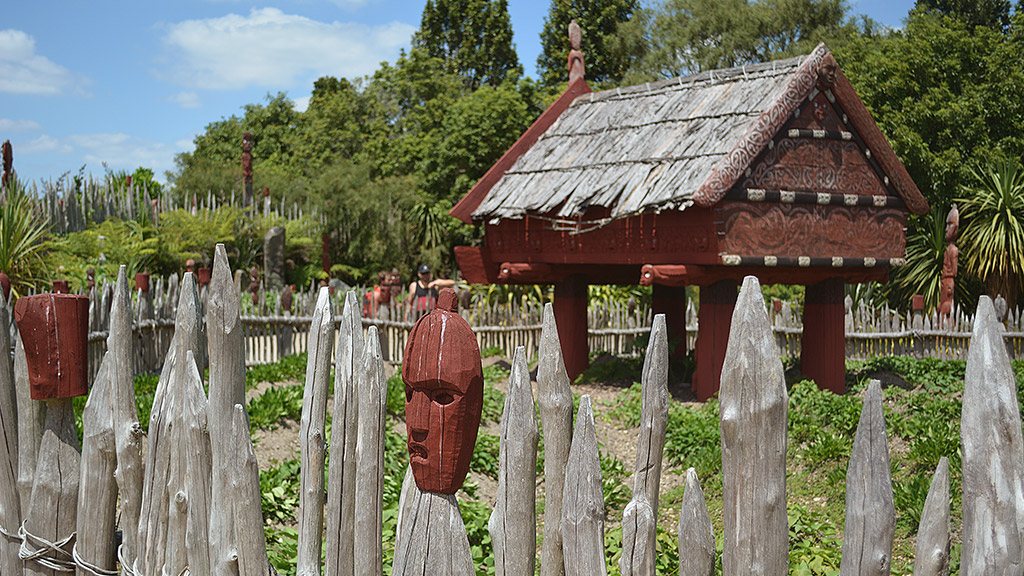So now you know that our very own NTO (National Tourism Organisation), Tourism New Zealand, is the oldest tourism marketing department in the world! The organisation has 13 offices around the globe and employs a staff of around 150 people who work together to market New Zealand to the rest of the world. TNZ is a crown entity which means it’s part of the State sector, funded by the government but a public body so has an independent Board that is appointed by ministers. The role of TNZ is to target international visitors from key markets around the world whom they know will stay for longer, spend more, visit more regions, and come outside of peak season. They partly do this by using their marketing tool ‘100% Pure New Zealand’. This campaign has evolved and changed since it was first created in 1999 to adapt to the changing various markets and to leverage high-profile events such as the LOTR trilogy and The Hobbit movies along with sporting events such as the RWC and America's Cup.
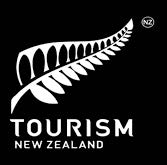
Tourism was New Zealand’s largest export delivering more than $40.9 billion to the economy before the Covid pandemic. It also accounted for 8.4% of the country’s employed workforce, which is almost 230,000 people. Of course, the figures fell out of the sky during the pandemic, and TNZ had to change direction and focus helping to
You have looked at some TNZ video collateral during your Marketing Course. Now check out these videos, and think about how the marketing strategy has changed over the years. Note down which market segments you think they might be trying to attract.
100% Pure New Zealand (3.27)
100% Pure New Zealand: Kia ora (2.28)
Stop dreaming about New Zealand and go. (1.30)
New Zealand Film Locations You Might Have Missed: Part One (1.00)
Important
Click on Domestic Consumer research, then look at the Domestic Growth insight tool, and the Domestic Traveller segments in the following link:
Learning Activity: TNZ profile
Click on the following PDF, the TNZ Visitor Profile Report, and then answer the following questions.
Please note: this report was published in May 2019; therefore, the content references international visitors. Even though Covid-19 shut the borders for two years and the numbers haven’t yet returned, we should understand the visitor profile pre-Covid-19 and what made New Zealand a great place to visit for the global community. The reason why we are studying this report is that as the borders reopen and international visitors return, it is important to recognise the various active considerer markets and their needs.
- In your own words, describe what constitutes an “active considerer?”
- What activities and attractions in New Zealand can you recommend for the following travellers, Takuya and James?
Post your responses to the Forum, TNZ Report.
Takuya
| Activity | Name of Attraction and Region |
|---|---|
| Natural landscape and scenery | |
| Short walks | |
| Hot pools | |
| Local food and wine |
James
| Activity | Name of Attraction and Region |
|---|---|
| Nature and wildlife | |
| Challenging and relaxing activities | |
| Geothermal sites | |
| Nature walks | |
| Experience Maori culture | |
| Film Locations |
TNZ’s goal is to maximise the net benefit of tourism. This is defined as a net positive benefit against four capitals:
- Economy – tourism contributes goods and service tax (GST) revenue, creates jobs, and increases productivity through regional and seasonal distribution.
- Nature – tourism is sustainable and regenerative and supports the management of New Zealand’s natural assets.
- Society – tourism supports regional amenities and creates productive, high-wage, enriching jobs for New Zealanders.
- Culture – tourism respects and champions te ao Māori, brings New Zealanders together, and enables us to celebrate who we are on the world stage. This document refers to what we call the ‘high-quality visitor’ or a ‘high-quality audience’.
These visitors and audiences are not solely defined by economic benefit; rather, they encompass a range of characteristics and exhibit behaviours that support New Zealanders’ views of tourism and whom we should share our unique place with. Throughout this document: The Statement of Intent (SOI) 2021-2025, when we speak about audiences or target markets, we generally refer to high-quality visitors unless otherwise stated. We explore the concept of the high-quality visitor under Strategic Intention Three.
Reading
Read more about the Statement of Intent (SOI) 2021-2025 here.
Treaty Of Waitangi
Te Tiriti o Waitangi (The Treaty of Waitangi) has significance today as it is widely accepted as New Zealand’s founding document which guides the relationship between the government and Māori. Signed on 6th February 1840 at Waitangi in the Bay of Islands, the principles of the Treaty are embedded into many tourism strategies and policies. A whakataukī (proverb) sourced from one of the translations of the Treaty reads:
“Toi te kupu, toi te mana, toi te whenua” – The permanence of the language, prestige, and land.
Whakataukī taken from a translation by Kingi Ihaka who credits the proverb to Tinirau of Whanganui -sourced from Te Ao Hou November 1957

The Three Main Principles
The three key principles of the Treaty are often referred to as the ‘three Ps’:
- Partnership
- Participation
- Protection
Ways that the 3 Ps’ of Te Tiriti o Waitangi are embedded into the values and processes of tourism businesses and associations are not limited to:
Partnership
This could mean working together with iwi and Māori communities to understand relevant tikanga when developing strategies. To include and involve Māori values in decision-making and planning and acknowledging and respecting tikanga.
Participation
This could be getting involved with local community projects to strengthen relationships and gaining Māori participation by way of consultation or employment etc.
Protection
Kaitiakitanga, or guardianship of the land and tikanga to preserve both the land and the culture for future generations.
Government agencies, tourism industry organisations, associations, and individual businesses work collaboratively with tāngata whenua to honour the values and principles of the Treaty. Most tourism employers will expect their employees to know about and work within these principles.
Tiaki Promise
The Tiaki Promise was created by both private and public sector organisations to raise awareness and encourage commitment to care for New Zealand. Seven entities worked together to develop the Tiaki Promise: TNZ, Air New Zealand, the Department of Conservation, Tourism Industry Aotearoa, Local Government New Zealand, New Zealand Māori Tourism, and Tourism Holdings Ltd.
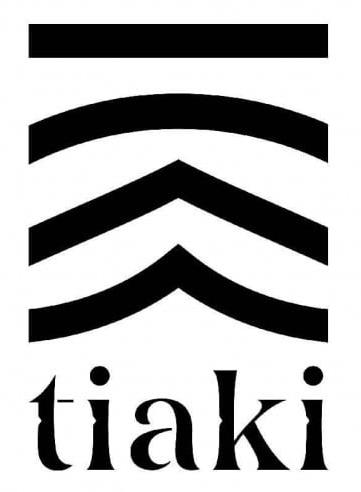
Tiaki means to care for people, place, and culture. Both tourists and people who call New Zealand home are encouraged to commit to and follow the Tiaki Promise thus acting as guardians to protect and preserve our home.
In Aotearoa New Zealand, people have a strong connection to the place around them. Tangata whenua (people of this land) see nature as something intrinsically intertwined with their own lives. For Māori, every mountain, every river, every tree has a story. These stories for part of their own identities and help shape their place in the world.Tiaki New Zealand, 2022
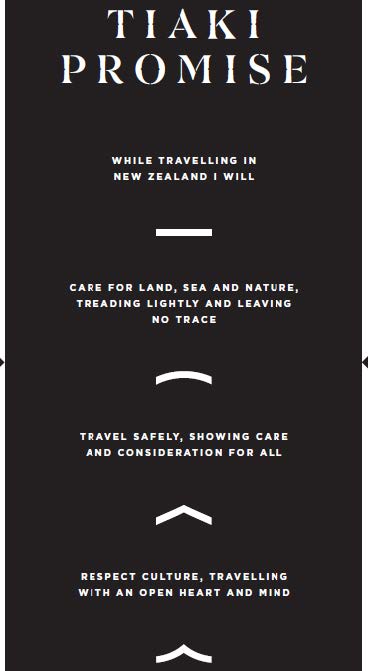
TNZ has a range of marketing materials in English, te reo Māori, German and Chinese available free of charge to help promote the commitment overseas to inbound visitors, and domestically here in New Zealand.
Explore
Air New Zealand’s safety video was inspired by the Tiaki Promise and follows a young man named Tiaki who sets off on an adventure across Aotearoa to visit 4 Guardians of this World. Review it here: www.tiakinewzealand.com
Tiaki invites us, both international and domestic visitors to form a deeper connection with place and to reflect this in our attitudes and behaviours.
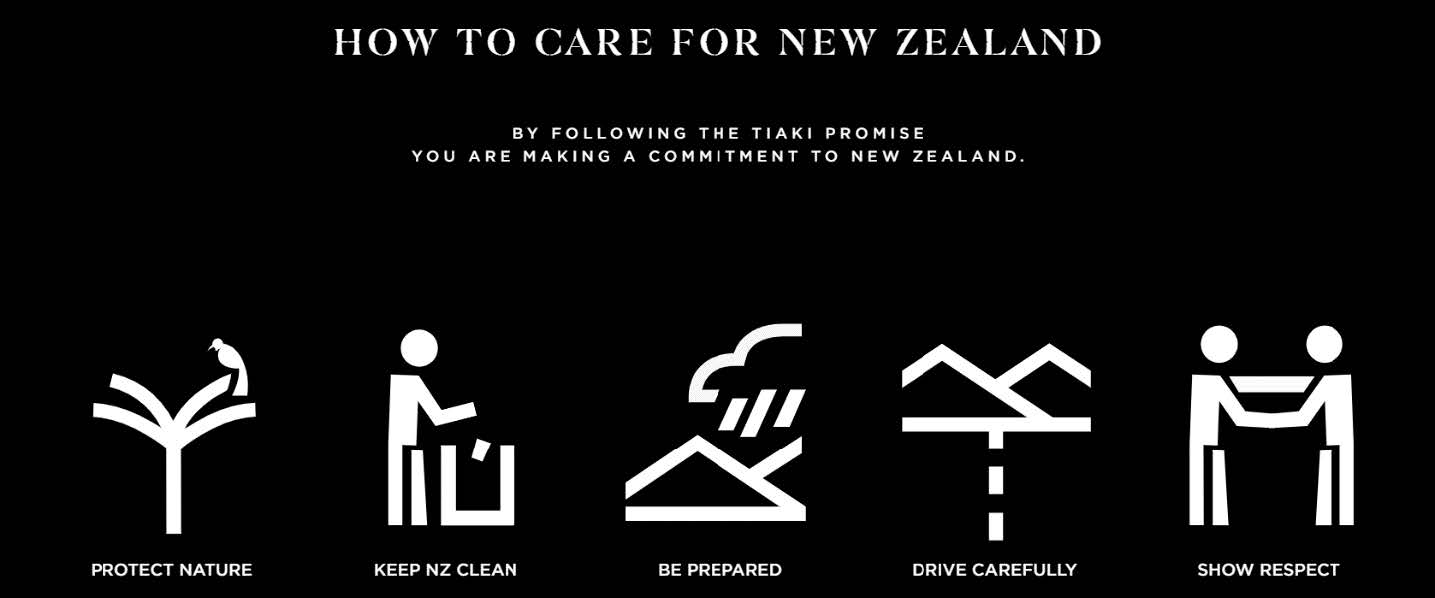
Important
Click on the Tiaki New Zealand website of how to care for New Zealand in the ways illustrated above.
https://www.tiakinewzealand.com/en_NZ/how-to-care-for-aotearoa/protect-nature/
Whilst TNZ is government-funded, Tourism Industry Aotearoa, (TIA), is an independent association made up of members from all sectors of New Zealand’s tourism industry. From SMEs (small and medium enterprises) to large tourism corporates, members find more influence working as one association to achieve more within the industry.

![[ADD IMAGE'S ALT TEXT]](/sites/default/files/Our%20Vision.jpg)
Image sourced: tia.org.nz
TIA is funded by annual fees of its members who represent all the key stakeholders of the New Zealand tourism industry which include:
- Ports
- RTOs (Regional Tourism Organisations: https://rtnz.org.nz/)
- Councils
- Ground handlers
- Shipping agents
- Airlines
- Tour operators
- Service operators
- Hospitality providers
- New Zealand Cruise Association Tourism New Zealand
Membership to TIA provides tourism businesses access to advice and support as well as presents opportunities to connect with industry partners. They are heavily focused on the recovery and future of the tourism industry in New Zealand and offer strength by way of the collective voice of their members. TIA members can have their say and contribute to shaping the tourism sector and the association can advise and influence government decisions to aid and support the industry moving forward. An example of this is when TIA advocated and lobbied the government to remove pre-departure testing (Covid) for travellers visiting New Zealand in time for the beginning of the ski season in 2022. (Tourism Industry Aotearoa, 2022)
Reflection
Visit the TIA website here, use the interactive graph, and make notes on what areas of the public sector are influenced by TIA.
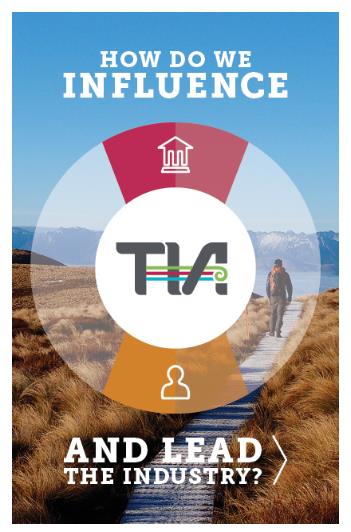
Tourism 2025 & Beyond
As previously discussed, New Zealand tourism businesses and associations use Te Tiriti o Waitangi to inform their processes and structures, and TIA are no exception.
The original programme of ‘Tourism 2025’ was released in 2014 during a time which saw massive international visitor statistics. In 2019, TIA introduced an updated strategic framework because of the growth achieved and the new challenges and opportunities which were presented as a result of industry success. This edition, which was focused on developing the industry beyond 2025, has an overall aim to improve overall sustainability within the industry whilst at the same time promoting growth.
TIA’s ‘Tourism 2025 & Beyond’ initiative is intrinsically linked to the three main Treaty principals and its goals are all based around developing an industry that benefits New Zealanders with sustainability at its heart:
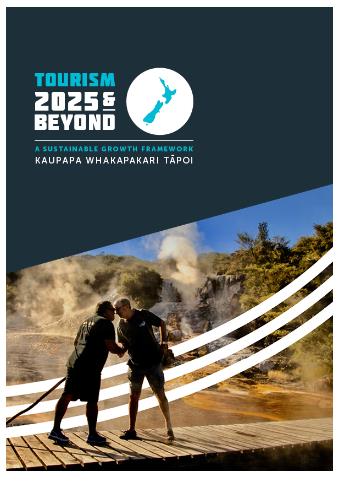
Our Goals
- Visitor - Deliver outstanding visitor experiences
- Community - New Zealanders are welcoming hosts
- Environment - Aotearoa is enhanced by tourism
- Economic - Grow tourism's contribution to New Zealand's economy
Learning Activity: Tourism 2025 & Beyond
Explore the Tourism 2025 & Beyond programme and reflect on the following questions, using your own words. You must read and digest this document to truly understand TIA's approach to the future of the industry.
- How do you feel the Tourism 2025 & Beyond framework upholds the three Ps of Te Tiriti o Waitangi?
- The world faces serious climate change and carbon emission issues, and globally, tourists recognise this. Sustainability is the key message woven throughout this framework, but what risks does New Zealand face if they don’t mitigate these risks?
Post your responses in the Forum, Tourism 2025 & Beyond.
The New Zealand-Aotearoa Government Tourism Strategy:
The New Zealand-Aotearoa Government's Tourism Strategy is more important than ever as they welcome visitors back to New Zealand. The Strategy sets out a more deliberate and active role for the government in tourism.
The government wants tourism growth to be productive, sustainable, and inclusive. Their goals are:
- Tourism supports thriving and sustainable regions
- Tourism sector productivity improves
- New Zealand-Aotearoa delivers exceptional visitor experiences
- Tourism protects, restores, and champions New Zealand Aotearoa's natural environment, culture, and historic heritage
- New Zealanders’ lives are improved by tourism
Important
This is the source: https://www.mbie.govt.nz/immigration-and-tourism/tourism/new-zealand-aotearoa-government-tourism-strategy/
Spend some time reviewing this Strategy, and this International Visitor Levy at this source: https://www.mbie.govt.nz/immigration-and-tourism/tourism/tourism-funding/international-visitor-conservation-and-tourism-levy/what-is-the-ivl/
Learning Activity: Tourism Strategy
Do you agree with tourists paying a visitor levy? If not – why not? If yes, explain why.
Post your responses in the Forum, Tourism Strategy.
Tourism Sustainability Commitment
The TIA developed and launched the Tourism Sustainability Commitment, (TSC) in 2017 as a tool to work alongside and in conjunction with the Tourism 2025 & Beyond framework. Developed by the tourism industry, for the tourism industry, the TSC has 4 elements of tourism sustainability. These are:
- Economic – Economically sustainable, resilient, and innovative businesses
- Visitor – World-leading experiences that exceed visitor expectations
- Community – Communities that benefit from and are supported by tourism
- Environment – Protecting and enhancing our natural environment
These elements have 12 commitments which are outlined below.
![[ADD IMAGE'S ALT TEXT]](/sites/default/files/NZ%20Tourism.jpg)
Every New Zealand tourism business is invited to join together and commit to the programme, working to create a robust, sustainable industry that contributes positively to the country economically, socially, and environmentally.
The aim is that every New Zealand tourism business will commit to sustainability by 2025.
The Vision
The TSC’s vision:
“Leading the World in Sustainable Tourism – Toitū te taiao, toitū te tāpoi.
E kōkiri ana e Aotearoa.
To deliver on this, we must grow an industry that delivers high-quality experiences for both domestic and international visitors while having a positive impact on local communities, contributing to the restoration and protection of our natural environment, and rebuilding the economic sustainability of the sector.”
The 12 Commitments
Economic
Tourism delivers opportunity and prosperity across the New Zealand economy
- Resilience
We focus on long-term business performance and resilience. - Investment
We invest to create value, and opportunities and to drive sustainable practices. - Innovation
We innovate to solve problems, create new ways to do things and increase productivity.
Visitor
New Zealand provides world-leading experiences for both international and domestic visitors
- Visitor Satisfaction
We strive to always meet or exceed visitor expectations. - Culture and Heritage
We embrace Aotearoa New Zealand's culture and heritage as part of delivering a unique and authentic visitor experience. - Visitor Engagement
We engage with visitors about how to be great travellers within Aotearoa New Zealand
Community
New Zealanders understand, support, shape and benefit from tourism operating in their communities.
- Employer of Choice
We attract, support and develop the workforce we need to flourish and succeed. - Community Engagement
We actively and positively engage with the communities in which we operate, taking a leadership role to champion causes that are important to the community. - Sustainable Supply Chains
We have socially and environmentally sustainable supply chains.
Environment
Tourism strongly contributes to protecting, restoring and enhancing New Zealand's natural environment and biodiversity.
- Restoring Nature
We contribute to protecting and enhancing Aotearoa New Zealand's environment, including water, biodiversity, landscapes and clean air. - Carbon Reduction
We act urgently to contribute to Aotearoa New Zealand's transition to a net zero carbon economy. - Eliminating Waste
We take responsibility for the entire life cycle of products and services we use and ultimately eliminate the waste associated with these.
Explore
Explore the Tourism Sustainability Commitment programme.
Learning Activity: Tourism Sustainability Commitment
Choose from one area of the commitment groups, (either 1-3, Economic Sustainability/4-6, Visitor Sustainability/7-9, Community Sustainability/ or 10-12, Environmental Sustainability).
What recommendations are made for tourism businesses to help them achieve their sustainability commitments from your chosen category.
Share your findings in your own words, with your fellow students in this forum.
Clue: have a look under the TAKE ACTION tab on the website https://sustainabletourism.nz/
Post your responses in the Forum, Tourism Sustainability Commitment.
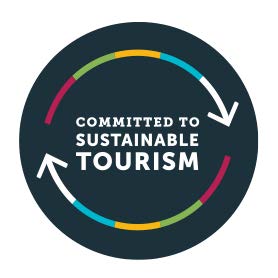
The Tourism Carbon Challenge
TIA also recognises that climate change is urgent and that we all need to take action to halt further negative impacts all around the world. Climate change is a real and serious issue and is already impacting hugely on the planet. The potentially irreversible damage to the planet is real, and TIA’s Tourism Carbon Challenge aims to significantly reduce the New Zealand tourism industry’s collective carbon footprint by 2030. The ultimate goal is to be net zero carbon before 2050.
TIA advocates that this can be achieved by working to working together as an industry and so as part of their commitment to bring about change, they offer advice and practical steps on how tourism businesses can manage their carbon emissions. They do this by providing helpful resources with information on mitigating your carbon footprint and how to develop a carbon offset programme. They also offer links to free tools that help calculate and assess your carbon footprint. After all, you need to measure your emissions to track your progress and successes. You can find more information here.
Watch this video
When The World Gets 1°C Hotter: Climate Change: The Facts │ BBC Earth (7.28)
Reminder
The difference between carbon neutral, net zero and climate positive.
Carbon neutral – means that any CO2 created and released into the atmosphere by a company’s activities is balanced out by an equivalent amount being removed. (e.g. carbon offsetting - planting trees, carbon capture, or mineralisation)
Net zero – means that no carbon emissions are released
Climate positive – means that a company’s activities go beyond achieving net zero by actually removing extra CO2 from the atmosphere.
Watch this video
3 ways to transform tourism to fight climate change │Edward Huijbens│TED (12.14)
Learning Activity: TED Talk Video
Review the TED talk video and reflect on the message that was delivered.
Write a short essay discussing the message that was delivered. Do you agree with the points raised and what do you think the potential impacts would or could be on the New Zealand tourism industry? (Minimum word count 300).
- How do you feel the Tourism 2025 & Beyond framework upholds the three Ps of Te Tiriti o Waitangi?
- The world faces serious climate change and carbon emission issues, and globally, tourists recognise this. Sustainability is the key message woven throughout this framework, but what risks does New Zealand face if they don’t mitigate these risks?
Post your responses in the Forum, TED Talk Video.
Because of tourism’s significant contribution to the New Zealand economy, and subsequent massive losses following the Covid pandemic, the Ministry of Business Innovation and Employment, (MBIE), partnered with various sectors of the tourism industry to develop an Industry Transformational Plan.
Review the Tourism Industry Transformational Plan and consider;
- What is an ITP?
- Why is it needed?
- What named reports are part of the framework of the ITP?
New heading: High Value / Quality Visitors
What is a high-value visitor, also known as a high-quality visitor?
A search on the term “high-value travellers” notes they are likely to spend more, stay longer, and disperse beyond hotspots. Additionally, they're motivated by nature, wildlife, aquatic, food, and hands-on experiences. So, there you go. The high-value traveller as defined by the tourism industry.
Read the following PDF document that contains two (2) articles to gather further insights.
High-quality visitors are defined by more than the money they spend — the way they contribute to Aotearoa matters too. We look at the type of visitor, their scope of activities, how they travel across seasons and regions, environmental consciousness, and engagement with our culture and communities. According to p.12 of the 2019 NZ-Aotearoa Government Tourism Strategy, entitled "Tourism Sector Productivity Improves" which can be downloaded here as a PDF . Focusing on these areas will help the economic sustainability of tourism, ensure our industry is resilient to shocks, and the tourism system is underpinned by secure, responsive funding streams that can be used to maintain and build the quality infrastructure, amenities, and attractions our visitors expect.
What would long-term success look like?
- The value of the industry continues to grow faster than the volume of visitors
- The regional spread of visitors has grown
- The seasonal spread of visitors has expanded
- The costs of managing attractions, access, and amenities are being met through sustainable, secure, and equitable funding streams
- The skill level and capability of the industry’s workforce has grown
- The industry is using more innovative technologies and systems to create higher-quality jobs
- Capital investment in the industry and the utilisation of existing amenities have improved
TNZ has a statement of intent for 2021-2025. It is:
You can download a copy of the TNZ Statement of Intent as a PDF copy here.
In particular look at Strategic Intention Three: "Maximise the Contribution of Visitors".
TNZ will work to better influence who chooses to visit New Zealand and what they choose to do when they get here. TNZ’s marketing and promotional activities are designed to create visitors who will spend more, visit more regions, and travel in the shoulder seasons. Pre-COVID-19, this resulted in:
- 14 percent higher spend per visit
- 45 per cent greater regional diversity in visits, and
- 28 per cent increased travel in shoulder seasons.
To achieve greater visitor value across the four capitals, as well as across regions and seasons, we are adopting a portfolio approach to marketing activities. Each market can contribute individually to our outcomes in different ways, for example through visiting outside of New Zealand’s peak season, or by focusing on specific regions or activities of interest to that international cohort.
Our strategic approach is underpinned by the concept of the high-quality visitor.
To be successful in future, however, we will need to think differently about how we are targeting high-quality visitors, building on the extensive knowledge we gathered pre-COVID-19. We are making a ground-breaking shift to find and define the TNZ consumer with the future of tourism in mind. As noted under Strategic Intention One, we will look beyond borders to target psychographic audiences (based on traits, personalities, values, opinions and attitudes) that will contribute more to New Zealand across the four capitals.
As TNZ develops these new audience mindsets, we will be able to understand visitor contribution and experience beyond a market-by-market approach. This will allow us to shape demand in more sophisticated and targeted ways. We will be innovative and responsive in how we segment and focus on markets and audiences.
As well as our traditional focus areas for visitor contribution – such as spend and regional and seasonal dispersal – this approach will enable us to consider how visitors are orientated towards climate consciousness, sustainable travel, environmentally regenerative tourism and a desire for culturally and socially enriching activities in New Zealand.
We will develop and set measures throughout this SOI that align with the economy, nature, society and culture. This will ensure our marketing activity is guided by holistic results and makes sense at different stages of the sector’s recovery and transition.
While TNZ does not lead tourism policy, to shape demand effectively and in line with Government and sector objectives, TNZ partners closely with industry, MBIE, DOC, RTOs and other agencies to understand and advise on supply-side opportunities, challenges and aspirations.
We will work with the industry to ensure businesses can take advantage of our audience targeting and insights which will in turn enable the connection of a higher value, culturally enriching and sustainable tourism product with visitors.
We will also continue our focus on influencing visitor behaviour through Tiaki – Care for New Zealand. The Tiaki Promise has a set of guiding principles for visitors to follow, showing them how to contribute to preserving and protecting our land. The Tiaki Promise will help to ensure visitors have a clear and compelling understanding of the expectations of travelling throughout our precious environment.
This exercise is to assist you in your critical thinking and help pre-plan for the assessment critique. There are two tasks to complete in this learning activity, which comprises two short articles and one radio interview. (Please review all articles).
Article 1: Re-evaluating New Zealand Tourism-What the Future Holds
Article 2: Tourism Can No Longer be Built on the Back of Cheap Labour
Radio Interview: Working Holiday Scheme Changes Needed
1. Reflecting on the reading, do you agree or disagree with the resources or not? Justify your answer.
Next, consider the following resolution:
“The New Zealand tourism industry needs value over volume”.
2. Complete the table in the forum, using statements or facts (evident in the resources to support your argument both for and against the above statement).
You will need to argue 3 points for and 3 points against the statement.
Post your responses and share them with your peers in the Forum, Check Your Knowledge.
